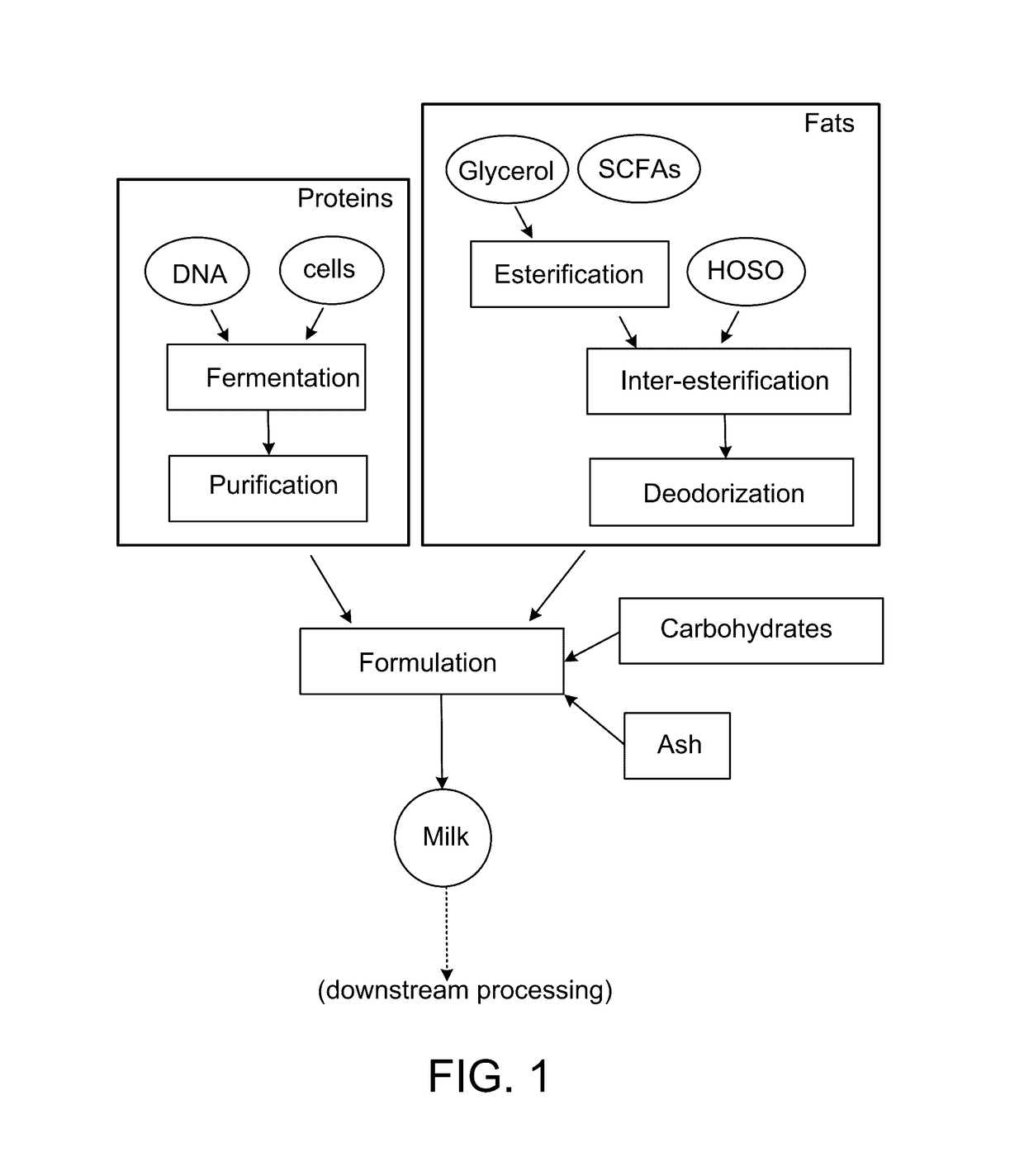Compositions comprising a casein and methods of producing the same
a casein and casein technology, applied in the field of dairy substitutes, can solve the problems of failure to form derivative products, significant levels of nitrate which have the potential to contaminate groundwater, etc., and achieve the effects of reducing environmental impact, enhancing the flavor profile of non-dairy milk substitutes, and reducing or eliminating antibiotic residues
- Summary
- Abstract
- Description
- Claims
- Application Information
AI Technical Summary
Benefits of technology
Problems solved by technology
Method used
Image
Examples
example 1
Vectors
[0256]Protein sequences bovine α-S1 casein (UniProt accession #P02662), bovine α-2 casein (UniProt accession #P02663), bovine β-casein (UniProt accession #P02666), bovine κ-casein (UniProt accession #P02668), bovine α-lactalbumin (UniProt accession #B6V3I5) and bovine β-lactoglobulin (UniProt accession #P02754) were obtained on Uniprot.org and altered with the following changes: removed 15 or 21-residue signal peptide from N-terminal end; added XhoI (CTC GAG) endonuclease recognition sequence and KEX endopeptidase recognition sequence (AAA AGA) to 5′ end of DNA; and added SalI (GTC GAC) endonuclease recognition sequence to 3′ end of DNA. An additional combination sequence was made by combining the sequences for the four caseins in the order shown above, separating each sequence with the following DNA phrase:
(SEQ ID NO: 128)GGC TCA GGA TCA GGG TCG AAA AGA GGC TCA GGA TCAGGG TCG.
[0257]Here the non-underlined segments encode a (GS)6 linker sequence for adequate posttranslational...
example 2
[0274]Triglyceride Synthesis
[0275]Milk fat triglycerides were made by transesterifying short-chain triglycerides into high oleic sunflower oil, the oil from a custom engineered variant of sunflowers which express the following ratios of fatty acid esters as described in Table 1:
TABLE 1FattyNuSun Mid-OleicHigh-OleicAcidsSunflower†Sunflower‡Sunflower†C8:0NDNDNDC8:0NDNDNDC10:0NDNDNDC12:0ND-0.1NDNDC14:0ND-0.20.4-0.8ND-0.1C16:02.0-7.64.0-5.52.6-5.0C16:1ND-0.3ND-0.06ND-0.1C17:0ND-0.2ND-0.06ND-0.1C17:1ND-0.1ND-0.06ND-0.1C18:01.0-6.52.1-5.02.9-6.2C18:1 14-29.443.1-71.8 75-90.7C18:246.3-74.018.7-45.3 2.1-17.0C18:3ND-0.3ND-0.1 ND-0.3C20:00.1-0.50.2-0.40.2-0.5C20:1ND-0.30.2-0.30.1-0.5C20:2NDNDNDC22:00.3-1.50.6-1.10.5-1.6C22:1ND-0.3NDND-0.3C22:2ND-0.3ND-0.09NDC24:0ND-0.50.3-0.4ND-0.5C24:1NDNDNDND = not detectable (ND defined as †From Codex Alimentarius (2001)‡From Table 3
www.sunflowernsa.com / uploads / resources / 51 / warner_.pdf
[0276]Short-Chain Triglyceride Preparation
[0277]The short-chain fatty ...
example 3
[0281]Milk Formulation
[0282]One non-limiting milk composition formulation is described below.
TABLE 4Components% (w / v) RangeAmount (g / L)Casein proteins 1-1010-100Whey proteins0-10-10Plant-based milk fats0-80-80 ml / LSugar0-50-50Ash0.1-1 1-10Calcium0.1-0.51-L X (Functional0-10-10 Ladditive)
[0283]Following Table 4, milk formulation is achieved through the following procedure, per 1 liter of milk. 26 grams of casein, 3.5 grams of whey and 5 grams of ash are combined and mixed well. 40 mL of triglycerides are thawed & heated to 55° C. Protein mixture is poured slowly into triglycerides and vortexed at high speed for five minutes. In the meantime, 3.5 grams of whey and 24 grams of galactose are added to 850 mL deionized water; mixture is heated to 37° C. Triglyceride / protein / ash mixture is moved into Waring commercial blender and blended at low speed. Whey / galactose / water mixture is poured slowly into blender; cap placed on blender. Mixture is blended at high speed for ten minutes. Deioni...
PUM
| Property | Measurement | Unit |
|---|---|---|
| diameter | aaaaa | aaaaa |
| concentration | aaaaa | aaaaa |
| diameter | aaaaa | aaaaa |
Abstract
Description
Claims
Application Information
 Login to View More
Login to View More - R&D
- Intellectual Property
- Life Sciences
- Materials
- Tech Scout
- Unparalleled Data Quality
- Higher Quality Content
- 60% Fewer Hallucinations
Browse by: Latest US Patents, China's latest patents, Technical Efficacy Thesaurus, Application Domain, Technology Topic, Popular Technical Reports.
© 2025 PatSnap. All rights reserved.Legal|Privacy policy|Modern Slavery Act Transparency Statement|Sitemap|About US| Contact US: help@patsnap.com



